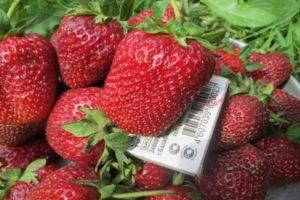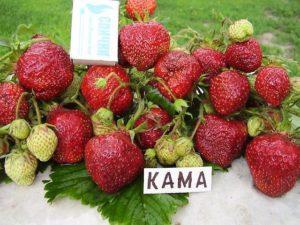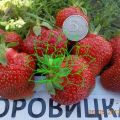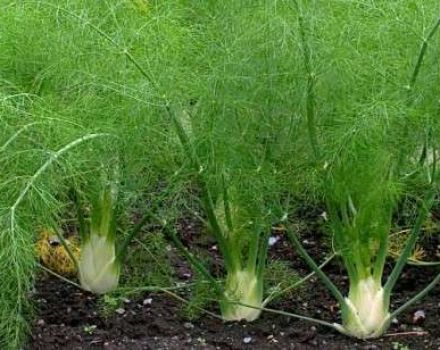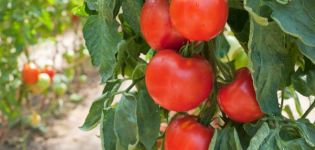Description of the strawberry variety Chamora Turusi, planting, growing and care
The cultivation of strawberries Chamora Turusi quickly fell in love with gardeners due to the high varietal characteristics of the plant. It is characterized by increased productivity, excellent taste characteristics of fruits, resistance to a number of common diseases. To obtain the desired result, it is important to adhere to simple but important planting and grooming requirements. The variety is unpretentious, but needs to meet certain requirements.
Description and characteristics of the Chamora Turusi variety
This variety loves care, but is not very demanding. The Japanese berry, bred by crossing two varieties, has become widespread due to its high varietal characteristics.
Berry
The berries are huge in size, which have an amazing aroma. The strawberry has a rounded conical shape. By appearance, the berries are comb, even folded, with peculiar combs. Weight is about 80 g, it depends on the rules of agricultural technology. Some reach a mass of 110 g. The color of the berry is red with a brownish, dark, even brick shade. By the 4th-5th year, the size of the fruits decreases.
Productivity
Mid-season ripening variety. The yield is impressive: from 1.8 to 2.5 kg per bush, subject to the rules of agricultural technology. Maximum fruiting in the 2-3rd year of life. Harvested within 5-6 years.
Sustainability
Differs in endurance, is not ranked with drought-resistant varieties, but is considered a winter-hardy representative. It is immune to powdery mildew. The variety has no immune protection against white and brown spot, root fungus, verticillosis. The bushes suffer from damage by the May beetle, weevil, slugs.
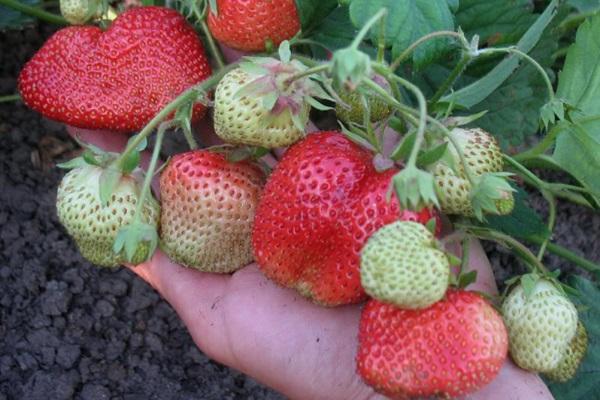
Breeding history and region of growth
The exact pedigree of the plant has not been established, but it is believed that the strawberry is the result of Japanese selection, obtained by crossing the plants of Gigantella and Queen Elizabeth. Due to the similarity of scientific descriptions of the bush and fruits mentioned in records in Japan, the variety is considered Japanese.
It is not recommended to cultivate bushes in regions with arid climates. When dried, strawberry bushes die. But they are quite resistant to low temperatures. When the temperature drops to -30about do not die. To do this, the strawberries must be properly prepared.
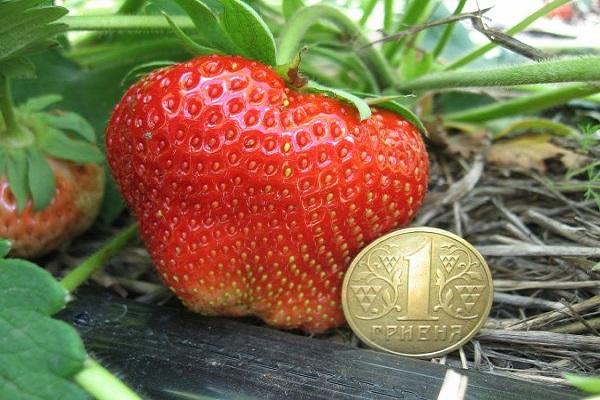
Pros and cons of strawberries
The berry has many advantages:
- amazing aroma of wild strawberries, like those growing in the forest;
- taste indicators: sweet, juicy;
- big size;
- fruits have no voids;
- has frost resistance;
- ease of care;
- minimum nutritional requirements;
- standard watering requirements;
- due to the density of berries, it has increased transportability;
- increased productivity.
In addition to the advantages, attention should be paid to the disadvantages:
- demanding on irrigation conditions;
- sensitive to temperature changes;
- certain requirements for the soil, grows on fertile land;
- a large area is required for cultivation;
- has protective functions against gray rot, brown spot.
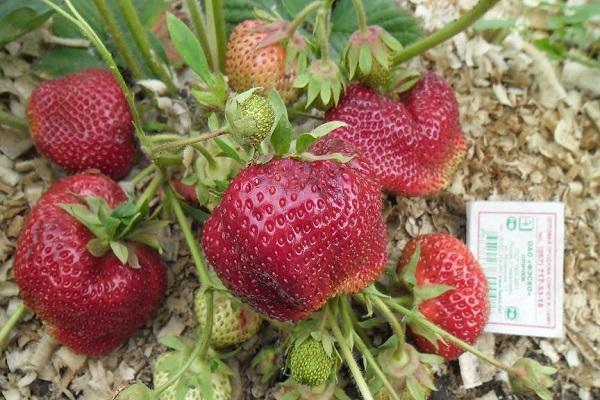
The nuances of planting a plant
Growing strawberries involves adhering to the rules for planting, the further result depends on this.
Site selection and soil preparation
For planting, it is recommended to allocate a spacious piece of land, since the bushes are quite powerful. Soil requirements:
- breathability;
- looseness;
- acidity level 5.5-7;
- predominantly sandy, chernozem (clay treated with fertilizers).
The selected area must be prepared. Dig up the earth, remove weeds, roots. The soil must be cleaned, even, loosened.
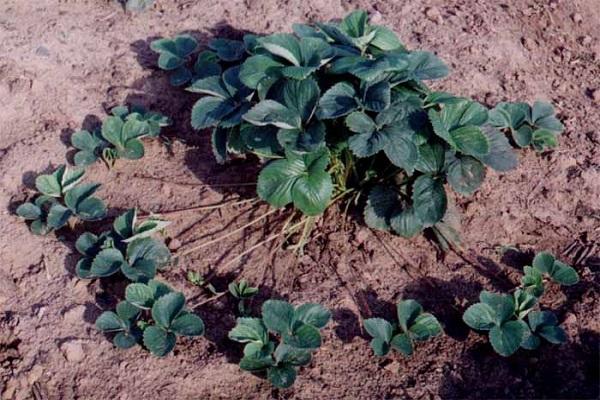
The bed needs good lighting, respectively, lowlands, a place under plants or fences will not work. It must be well ventilated to prevent the development of fungal diseases on the bushes.
Boarding time
The planting time of strawberries is directly dependent on climatic indicators. In the middle lane, it is produced in the last days of August, and in regions with a warm climate, which are characterized by little snow in winter, in May.
In temperate climates, the preferred planting time is autumn, when a more favorable temperature and humidity conditions are established. Gardeners advise to prepare beds for planting bushes in the fall: dig up, fertilize and mix with dolomite flour.
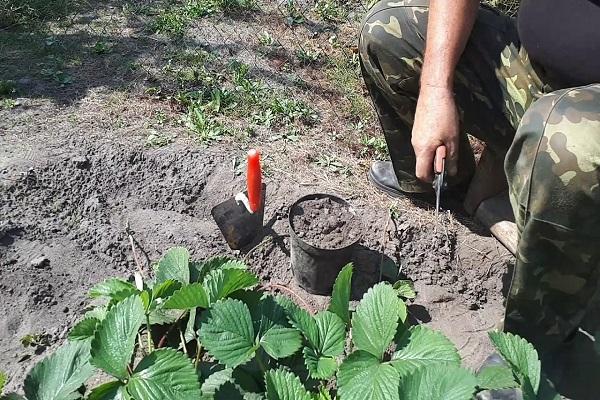
Planting strawberries in the garden
Strawberries do not tolerate thickening of bushes, it is recommended to maintain a distance of 0.35 m between them.In places with high humidity, the recommended distance is 0.5 m.
Sequence of actions for landing:
- Make holes with a depth and diameter of 0.3 m, pour in water.
- Despite the powerful look of the bush, you need to work with it carefully. Place the roots in the hole, the core is level with the ground. If placed higher, the plant will dry out, lower - it will begin to rot.
- Gently sprinkle the bush with earth, water.
- Fertilizing is not required if fertilizers were added to the soil during digging.
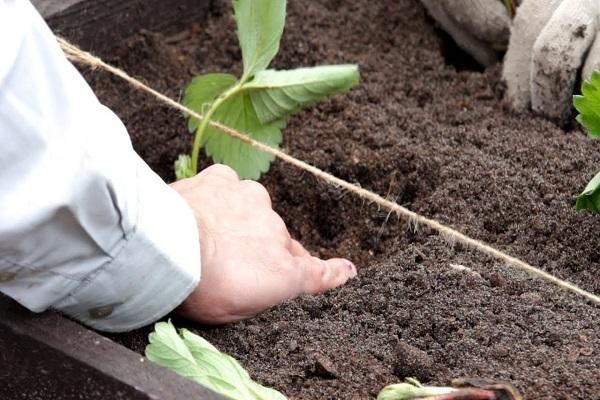
How to properly care for strawberries?
To obtain the desired result, it is important to comply with simple but important requirements for caring for strawberries.
Watering and fertilizing
The plant is demanding for watering. If there is not enough moisture, the berry does not gain mass, becomes hollow inside and dry, looks lethargic. But it is sweeter due to the higher sugar content, the aroma is stronger. The root system of the plant also suffers from a lack of moisture. Drip irrigation works well.
Excess moisture also negatively affects taste parameters. Fruits become watery, sweetness decreases, transportability deteriorates, decay occurs, brown spotting, gray rot spreads.
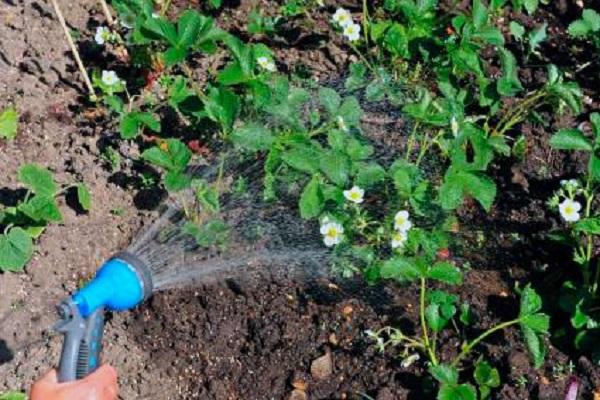
Pruning and loosening
From mid-August, it is necessary to trim the leaf plates and whiskers near the bushes. Treat the soil with a fungicide (2% solution). If there are bald spots of soil in the root area, cover them with a substrate.
Mulching bushes
Mulching strawberries is carried out to prevent the development of diseases, moisture retention. After mulching, the berries remain clean.It is carried out when tying berries on the bushes, to prevent the contact of the peduncles with the ground. Sawdust, needles, straw, humus are used.
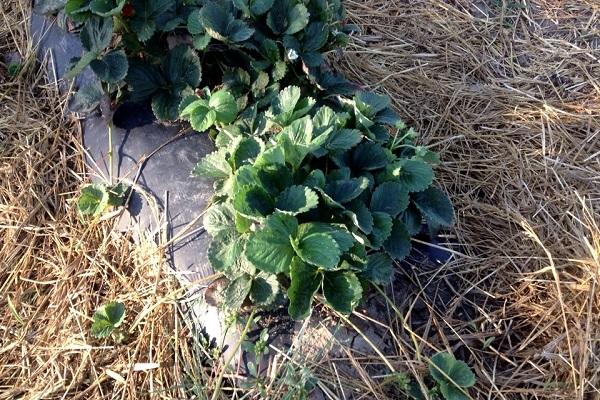
Reproduction methods
There are several ways to propagate strawberries:
- seed material;
- mustache;
- division.
The gardener chooses a breeding method convenient for himself, taking into account the pros and cons of each.
Mustache
Mustache reproduction is the most convenient and easiest way. The mother shrub must be healthy with excellent performance.
For reproduction you need:
- choose a plant that is 2-3 years old;
- a mustache with the first rosette is left at the bush, remove the others;
- attach the socket to the ground;
- the shoot takes root within a month;
- dig a rosette with a lump of soil, cut off the antennae, if it has not rotted;
- plant a bush on a prepared ridge.
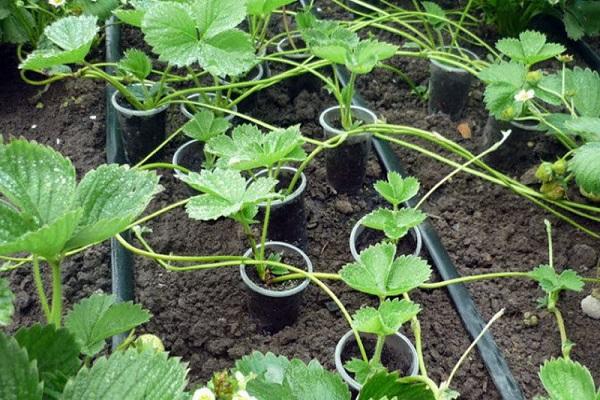
Dividing the bush
This method involves dividing a healthy bush into several outlets. Each should have at least 4-5 leaf plates, root 50-60 mm in length.
Scheme of actions:
- select a bush, dig up;
- chicken out the earth;
- place in a container with water to facilitate division;
- trim the roots so that the length is about 50-60 mm, this will stimulate the growth of lateral roots;
- land on the prepared site.
Seeds
When grown by seeds, the plant is less susceptible to fungal infections, but the method is more complicated. By following certain rules, you can grow a large number of sturdy plants. Seeds are recommended to be purchased in specialty stores or prepared by yourself. To do this, you need to take a healthy berry, cut the skin thinly, put it on paper and dry it.
Primary requirements:
- fill the container for planting with soil;
- sprinkle seeds on top of the soil, do not sprinkle with earth;
- sprinkle with snow;
- put in the cold (at least +2 aboutC) for a period of up to 2 weeks;
- place in room conditions;
- water when sprouts appear as they dry;
- plant bushes after the appearance of the first two leaf plates;
- plant on a ridge when there is no threat of frost.
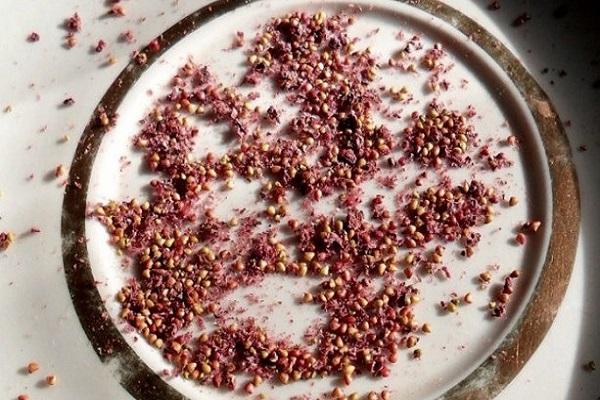
What diseases should you be afraid of?
This strawberry variety is protected from a number of diseases. But if the basic requirements for care are not followed, the plant can get sick. With severe damage to the bushes, treatment does not always give a positive result, therefore it is important to carry out preventive measures and inspect the bushes for the timely identification of the problem.
Verticillosis
It is characterized by wilting of the plant, yellow spots with a red tint appear, and the bloom of the tuber has a black color. For treatment, it is recommended to use "Fundazol", "Benorad". Treatment of the affected plant is carried out three times per season.
For prevention, soak the roots in a weak manganese solution before planting. In addition, remove damaged leaf plates and branches in time.
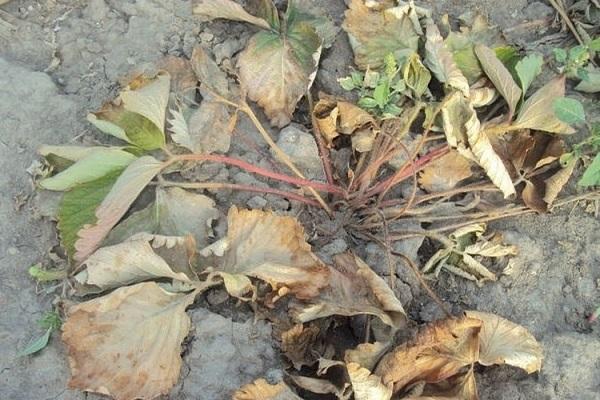
Fusarium
It is characterized by yellowing, fast drying of the sheet plates and the entire rosette. The mustache turns brown. It is recommended to treat the bushes with "Fundazol", "Benomil", "Benorad". If the plant is not rescued, after removing it, treat the soil with "Nitrofen".
For prevention, introduce dolomite flour into the soil, treat the soil with a fungicide in the spring.
Gray rot
This rot forms dark gray spots on the berries. They are covered with downy black dots. It is recommended to treat the affected bushes with "Fundazol", "Bayleton", "Teldor".
For prevention, it is recommended to leave a sufficient distance between the tubers, to rejuvenate the planting in time, not to use fresh manure for fertilization.
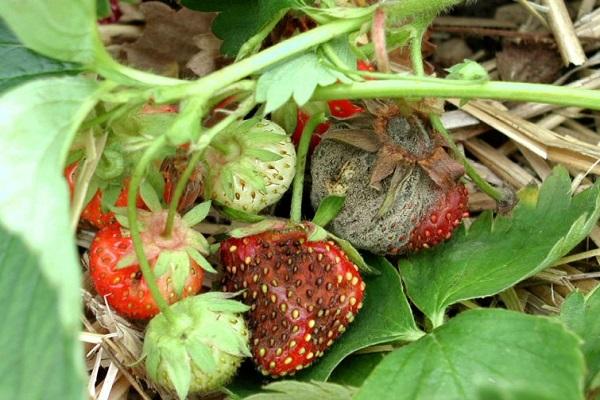
Black root rot
It is also called rhizoctoniasis. It affects the root system, is characterized by the appearance of spots with a brown color, the leaves dry out and fall off. The plant cannot be cured, it is recommended to take preventive measures when planting.
Pest control
In addition to fungal diseases, the plant is overcome by harmful insects. Among them are the beetle larvae. When damaged, the leaf plates turn intensely yellow and fall off at the beginning of summer. When attacked by a strawberry tick, the leaf plate deforms and twists.

If pests appear, immediately take the necessary measures to preserve the plant. It is recommended to treat with "Karbofos", "Fitoverm", "Neoron". From the appearance of the May beetle, for prevention, treat the soil before planting with Bazudin, Aktar, and Antichrusch.
Everyone can grow a crop with large berries, you need to show a little effort, patience and give the plant the necessary care.
